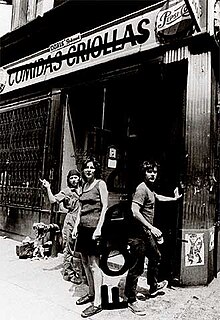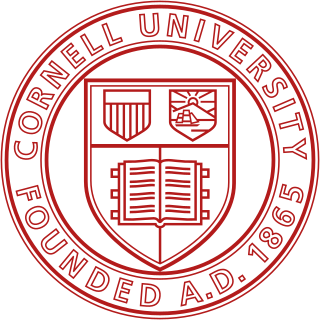
arXiv is a repository of electronic preprints approved for posting after moderation, but not full peer review. It consists of scientific papers in the fields of mathematics, physics, astronomy, electrical engineering, computer science, quantitative biology, statistics, mathematical finance and economics, which can be accessed online. In many fields of mathematics and physics, almost all scientific papers are self-archived on the arXiv repository. Begun on August 14, 1991, arXiv.org passed the half-million-article milestone on October 3, 2008, and had hit a million by the end of 2014. By October 2016 the submission rate had grown to more than 10,000 per month.

Richard Meier is an American abstract artist and architect, whose geometric designs make prominent use of the color white. A winner of the Pritzker Architecture Prize in 1984, Meier has designed several iconic buildings including the Barcelona Museum of Contemporary Art, the Getty Center in Los Angeles, and San Jose City Hall.

The College of Architecture, Art, and Planning (AAP) at Cornell University is one of the world's most highly regarded and prestigious schools of architecture and has the only department in the Ivy League that offers the Bachelor of Architecture degree. According to DesignIntelligence, Cornell architecture students are the most desired recent graduates by architecture firms, especially in New York City. The department has one of the largest endowments of any architecture program, including a $20 million endowment by Cayuga County resident Ruth Price Thomas in 2002. The Master of Regional Planning (M.R.P.) professional degree program at AAP has been consistently ranked in the top 10 in the nation, according to Planetizen's Guide to Graduate Urban Planning Programs.

The Cornell University Library is the library system of Cornell University. As of 2014, it holds over 8 million printed volumes and over a million ebooks. More than 90 percent of its current 120,000 periodical titles are available online. It has 8.5 million microfilms and microfiches, more than 71,000 cubic feet (2,000 m3) of manuscripts, and close to 500,000 other materials, including motion pictures, DVDs, sound recordings, and computer files in its collections, in addition to extensive digital resources and the University Archives. It is the sixteenth largest library in North America, ranked by number of volumes held.

Gordon Matta-Clark was an American artist best known for his site-specific artworks he made in the 1970s.

Lawrence Jordan is an American independent filmmaker who is most widely known for his animated collage films. In 1970 he received a Guggenheim Fellowship to make Sacred Art of Tibet.

The Herbert F. Johnson Museum of Art is an art museum located on the northwest corner of the Arts Quad on the main campus of Cornell University in Ithaca, New York. Its collection includes two windows from Frank Lloyd Wright's Darwin D. Martin House, and more than 35,000 other works in the permanent collection. It was designed by architect I.M. Pei and is known for its distinctive concrete facade.

Fedora is a digital asset management (DAM) architecture upon which institutional repositories, digital archives, and digital library systems might be built. Fedora is the underlying architecture for a digital repository, and is not a complete management, indexing, discovery, and delivery application. It is a modular architecture built on the principle that interoperability and extensibility are best achieved by the integration of data, interfaces, and mechanisms as clearly defined modules.
Weiss/Manfredi is a multidisciplinary New York City-based design practice that combines landscape, architecture, infrastructure, and art. The firm's notable projects include the Seattle Art Museum's Olympic Sculpture Park, the Brooklyn Botanic Garden Visitor Center, the Tata Innovation Center at Cornell Tech, the Singh Center for Nanotechnology at the University of Pennsylvania, the Museum of the Earth the Embassy of the United States, New Delhi, and Hunter's Point South Waterfront Park.

Cornell University is a private and statutory Ivy League research university in Ithaca, New York. Founded in 1865 by Ezra Cornell and Andrew Dickson White, the university was intended to teach and make contributions in all fields of knowledge—from the classics to the sciences, and from the theoretical to the applied. These ideals, unconventional for the time, are captured in Cornell's founding principle, a popular 1868 Ezra Cornell quotation: "I would found an institution where any person can find instruction in any study."

Werner Hans Peter Vogels is the chief technology officer and vice president of Amazon in charge of driving technology innovation within the company. Vogels has broad internal and external responsibilities.
Charles Babcock was an American architect, academic, Episcopal priest and founding member of the American Institute of Architects.
Structured storage is computer storage for structured data, often in the form of a distributed database. Computer software formally known as structured storage systems include Apache Cassandra, Google's Bigtable and Apache HBase.

Caroline O'Donnell is an architect, writer, and educator. She is the founder and sole-proprietor of the firm CODA, based in Ithaca, NY, USA. CODA won the PS1 MoMA Young Architects Program in 2013 and built "Party Wall" at PS1 in Long Island City, New York. O’Donnell is the Edgar A. Tafel associate professor of architecture and director of the Master of Architecture Program at Cornell University and visiting associate professor at Harvard GSD in Fall 2018. Her first book "Niche Tactics: Generative Relationships between Architecture and Site," was published in April 2015.

New Classical architecture is a modern movement in architecture that continues the practice of classical and traditional architecture. It can be considered as the modern continuation of the Neoclassical movement and other revivalist movement that may or may not fall to the umbrella term; Classical architecture. The design and construction of buildings in these traditions is continuous throughout the twentieth and twenty-first centuries, even as modernist and other post-classical theories of architecture have been more dominant. Since New Classical architecture is not an architectural style and can appear in various forms, contemporary classical buildings might be also, although not correctly, be described with the terms Traditionalism, Neo-Historism, or simply Neoclassical Architecture, implying the continuation of a specific historical style.

An architectural style is characterized by the features that make a building or other structure notable or historically identifiable. It is a sub-class of style in the visual arts generally, and most styles in architecture related closely to the wider contemporary artistic style. A style may include such elements as form, method of construction, building materials, and regional character. Most architecture can be classified within a chronology of styles which changes over time reflecting changing fashions, beliefs and religions, or the emergence of new ideas, technology, or materials which make new styles possible.

Jorge Otero-Pailos is an artist, preservation architect, theorist and educator, commonly associated with experimental preservation and the journal Future Anterior. He is best known for his “The Ethics of Dust” ongoing series of artworks derived from the cleaning of monuments, which was exhibited at the 53rd Venice Biennale. Westminster Hall, the Victoria & Albert Museum, and SFMoMA, amongst others. He is Director and Professor of Historic Preservation at Columbia University Graduate School of Architecture, Planning and Preservation.

Future Anterior is a biannual peer-reviewed academic journal published by the University of Minnesota Press. The editor-in-chief is Jorge Otero-Pailos.

















